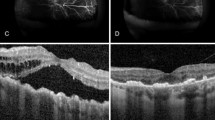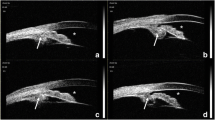Abstract
Purpose
To describe the clinical findings and management of eyes affected by uveal effusion syndrome (UES) presenting with clinical features mimicking inflammatory ocular diseases, treated using individualized surgical approaches.
Methods
We report a consecutive interventional case series of seven eyes of four patients affected by UES. On presentation in our clinic, all patients showed signs of steroid effects as a consequence of a presumptive diagnosis; one eye had undergone vitrectomy for retinal detachment (RD), without benefit. Diagnosis of UES was based on ophthalmic examination, ultrasonography, fluorescein angiography, biometry and magnetic resonance imaging. Five eyes with active disease were treated using scleral thinning surgical procedures based on the extent and characteristics of the disease: sclerectomy sites were ultrasound-guided to the area of maximal choroidal swelling, associated with evacuative puncture in the case of bilateral funnel-shaped RD.
Results
One patient was diagnosed with type 1 UES, two with type 2, and one with type 3. Mean postoperative follow-up was 26 months. In all eyes, surgery resolved the ciliochoroidal and retinal detachment and improved visual acuity. In two eyes, visual restoration was limited by a prolonged disease course.
Conclusion
UES may be mistaken for other sources of ciliochoroidal effusion. Early diagnosis and treatment is critical to avoid unnecessary procedures and to prevent severe visual loss as a result of neuroretinal damage. Surgical treatment based on the extent and characteristics of the disease may be effective for the resolution of ciliochoroidal effusion, even in type 3 UES, where conventional surgery has proved unsuccessful.




Similar content being viewed by others

References
Gass JD, Jallow S (1982) Idiopathic serous detachment of the choroid, ciliary body, and retina (uveal effusion syndrome). Ophthalmology 89(9):1018–1032
Besirli CG, Johnson MW (2013) Uveal Effusion Syndrome and Hypotony Maculopathy. In: Ryan SJ, Schachat AP, Wilkinson CP, Hinton DR, Sadda SR, Wiedemann P (eds) Retina, vol Chapter 73, Fifth Editionth edn., pp 1306–1317
Johnson MW, Gass JD (1990) Surgical management of the idiopathic uveal effusion syndrome. Ophthalmology 97(6):778–785
Schneiderman TE, Johnson MW (1997) A new approach to the surgical management of idiopathic uveal effusion syndrome. Am J Ophthalmol 123:262–263.18
Akduman L, Adelberg DA, Del Priore LV (1997) Nanophthalmic uveal effusion managed with scleral windows and topical mitomycin-C. Ophthalmic Surg Lasers 28:325–327.19
Brockhurst RJ (1980) Vortex vein decompression for nanophthalmic uveal effusion. Arch Ophthalmol 98(11):1987–1990
Gass JDM (1983) Uveal effusion syndrome. A new hypothesis concerning pathogenesis and technique of surgical treatment. Retina 3:159–163
Casswell AG, Gregor ZJ, Bird AC (1987) The surgical management of uveal effusion syndrome. Eye (Lond) 1:115–119
Faulborn J, Kölli H (1999) Sclerotomy in uveal effusion syndrome. Retina 19(6):504–507
Uyama M, Takahashi K, Kozaki J et al (2000) Uveal effusion syndrome: clinical features, surgical treatment, histologic examination of the sclera and patho-physiology. Ophthalmology 107:441–449
Ghazi NG, Richards CP, Abazari A (2013) A modified ultrasound-guided surgical technique for the management of the uveal effusion syndrome in patients with normal axial length and scleral thickness. Retina 33(6):1211–1219
Jackson TL, Hussain A, Morley AM et al (2008) Scleral hydraulic conductivity and macromolecular diffusion in patients with uveal effusion syndrome. Invest Ophthalmol Vis Sci 49:5033–5040
Ward R, Gragoudas E, Pon D et al (1988) Abnormal scleral findings in uveal effusion syndrome. Am J Ophthalmol 106:139–146
Stewart D, Streeten B, Brockhurst R et al (1991) Abnormal scleral collagen in nanophthalmos: an ultrastructural study. Arch Ophthalmol 109:1017–1025
Vine A (1986) Uveal effusion in Hunter’s syndrome: evidence that abnormal sclera is responsible for uveal effusion syndrome. Retina 6:57–60
Forrester JV, Lee WR, Kerr PR, Dua HS (1990) The uveal effusion syndrome and trans-scleral flow. Eye (Lond) 4:354–365
Compliance with ethics guidelines
All authors certify that they have no affiliations with or involvement in any organization or entity with any financial interest (such as honoraria; educational grants; participation in speakers’ bureaus; membership, employment, consultancies, stock ownership, or other equity interest; and expert testimony or patent-licensing arrangements), or non-financial interest (such as personal or professional relationships, affiliations, knowledge or beliefs) in the subject matter or materials discussed in this manuscript.
Funding
No funding was received for this research.
Human and animal rights and informed consent
All procedures performed in studies involving human participants were in accordance with the ethical standards of the institutional and/or national research committee and with the 1964 Declaration of Helsinki and its later amendments or comparable ethical standards. Informed consent was obtained from all individual participants included in the study.
Author information
Authors and Affiliations
Corresponding author
Rights and permissions
About this article
Cite this article
Maggio, E., Polito, A., Prigione, G. et al. Uveal effusion syndrome mimicking severe chronic posterior uveitis: a case series of seven eyes of four patients. Graefes Arch Clin Exp Ophthalmol 254, 545–552 (2016). https://doi.org/10.1007/s00417-015-3176-y
Received:
Revised:
Accepted:
Published:
Issue Date:
DOI: https://doi.org/10.1007/s00417-015-3176-y



